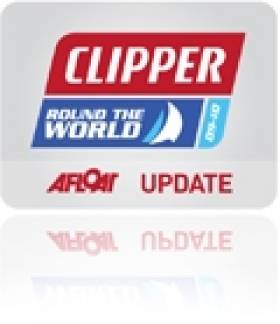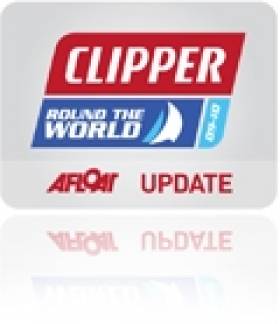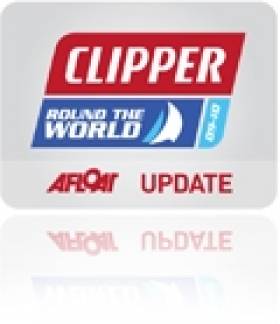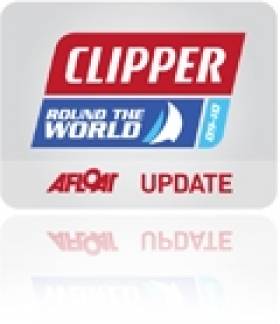Displaying items by tag: Clipper Round The World Yacht Race
Sailing legend Sir Robin Knox-Johnston has announced a brand new fleet of 70-foot racers for the Clipper Round the World Yacht Race.
Top naval architect Tony Castro has been commissioned to design the Clipper 70 fleet that will compete in the race from 2013 onwards.
The new yachts, to be built in China and fitted out by international suppliers, will have an increased crew capacity of 22, and feature a new hull design optimised for performance that should see speeds increase to more than 30 knots in the right conditions.
Other features include twin helms, twin rudders and a six-food bowsprit which will allow for the use of a huge Code Zero sail to complement the Yankee headsails, staysail and mainsail.
The Clipper Round the World Yacht Race is open people from all walks of life regardless of previous sailing experience.
In its 15-year history the race "has changed people’s lives and turned almost 3,000 sailing novices into experienced ocean racers", according to Knox-Johnston.
Clipper Ventures chief excective William Ward added: "Crew places on the last race sold out well in advance and Clipper 11-12 is set to do the same. We will therefore be using the 2011 London International Boat Show to launch our crew recruitment drive for Clipper 13-14 and beyond.”
The Clipper 11-12 race - the last to feature the Clipper 68 sailing the 40,000-mile (64,000 km) round-the-world course - will commence this August.
Knox-Johnston in Search for Ten Skippers
Sailing legend Sir Robin Knox-Johnston has launched his latest search for ten exceptional skippers to lead the internationally sponsored teams in the next edition of the Clipper Round the World Yacht Race. Clipper 11-12 will start form the UK in August next year and on board the matched fleet of stripped down 68-foot ocean racing yachts will be teams of novice crews representing all walks of life. The only professional sailor on board, the skipper has the challenge of turning such a diverse mix of people into a finely-honed racing team and it's one that professionals understand can deliver valuable benefits to their CV.
Sir Robin says, "Tackling this unique challenge, with its roaring gales and towering seas, as well as the frustrations of tricky calm spells, is no mean feat. The skippers we are looking for need to be up to the challenge of competitively racing our 68-foot yachts around the world with a non-professional crew onboard.
"The successful individuals must have the ability to draw the line between competitiveness and safety, whilst also motivating a sometimes exhausted crew into an enthusiastic and committed team.
"Leading a team of novice sailors in a race around the world is one of the hardest and most challenging jobs that any skipper could ever undertake and not everybody is up to this challenge."
Successful candidates will skipper one of the Dubois designed Clipper 68s and must also have an understanding of the commercial and media demands of this high-profile global event which can help launch a skipper's career.
The youngest skipper to win the Clipper Race was Alex Thomson who was just 25 when he led a team in the 1998 edition of the race. Twelve years later and Alex is getting his brand new IMOCA Open 60, Hugo Boss, ready for the double-handed Barcelona World Race which starts in December. The Gosport based sailor is widely considered to be one of the UK's top solo ocean racers and once he has returned for the Barcelona World Race he will be hoping to fulfil his dream by becoming the first non-Frenchman to win the Vendee Globe.
Other Clipper skippers who have gone on to secure sponsorship for solo ocean racing include Hannah Jenner who skippered in both the Clipper 07-08 and 09-10 Races. Hannah will be taking part in the Global Ocean Race next year, a 30,000-mile double-handed race around the world. Similarly Clipper 09-10 skipper, Chris Stanmore-Major is about to set off on his 2,500-mile qualifying passage for the VELUX 5 OCEANS race onboard his Open 60 Spartan having secured sponsorship to take part in what is deemed to be 'The Ultimate Solo Challenge'.
Interested skippers need to have the correct level of qualifications, including an MCA approved Ocean Yachtmaster. They need to be excellent sailors who put seamanship and safety first, have a proven track record in sail training and can demonstrate that they are strong team leaders.
Clipper Race Director Joff Bailey, skipper of New York in the Clipper 05-06 Race, says, "Being a race skipper in the Clipper Round the World Yacht Race was one of the hardest jobs I have ever done. However, the reward and satisfaction when you see the crew that you have trained react to situations as though they were full-time professionals and the look of achievement on their faces when they have crossed an ocean and finished a race, is the best high in the world."
If you think you are up for the challenge and have the right characteristics and experience contact Sir Robin by email on [email protected] to request an application form.
After a thrilling week of festivities the Clipper Round the World Yacht Race Fleet has left Cork to begin the final leg of the race. The Clipper Fleet left Port of Cork City Marina in a Parade of Sail at 13.30 today with a Clipper Fleet Departure Ceremony with The Band of the 1st Southern Brigade and Lord Mayor Cllr Michael O'Connell presiding over the farewell proceedings.
At the ceremony he said "We would like to say thanks to our Cork Yacht and Skipper Hannah Jenner- they have given us enormous pride since they arrived here and over the last couple of months as well. We wish them very well now on their voyage over to Holland over the next few days. And I want to thank everybody for coming down here today for giving such a massive send off".
It has been a hugely successful week for the Cork Clipper Festival which saw official attendance figures reaching 25,000 on Wednesday and 20,000 visitors on Thursday. Friday's Festival Finale was an appropriate fanfare farewell which saw Cork's own global internet sensation Crystal Swing entertain a packed crowd at the main stage at the Race Village before The Walls closed the curtain on an amazing week of live music entertainment.
Listen to Cork Skipper Hannah Jenner on our special Cork Podcast HERE
Cork Clipper Festival to Conjure Galway Volvo Magic
Cork Clipper Festival goers are in for a treat this week as the festival moves to Cork from Kinsale from Wednesday 7th July to the festival finale on Friday 9th July.
Fiona Bolger and Maria Moynihan-Lee, the same team behind the hugely successful Galway Volvo Ocean Race, have been the creative forces behind the Cork Clipper Festival which is expected to generate €10m in the local economy with 100,000 visitors expected.
The Clipper Fleet will leave Kinsale Harbour in a Parade of Sail at 11 am and will be visible from several Cork coastal areas passing Cobh between 2.30 and 3.30 and festival organizers have urged coastal dwellers and visitors to secure a good vantage point to wave at the nautical heroes who have circumnavigated the globe.
The yachts are expected into the Port of Cork City Marina at 5pm and the people of Cork are invited to welcome the Clipper Fleet at the Race Village on Albert Quay. After this weekend's fantastic festivities in Kinsale the Clippers' welcome to the Port of Cork is expected to be even bigger with the Race Village opening daily from 10 am until 10.30 am featuring live music and entertainment.
Ballymaloe Country Relish will greet the Clipper Round the World Yacht Race with freshly made sandwiches prepared in Ballymaloe House. Locally sourced fillings including glazed ham from Cormac O'Connor in Mayfield, roast turkey from Nora Ahern in Midleton, Imokilly Cheddar, homemade mayonnaise, Robyn Allen's organic salads, Ballymaloe Country Relish and Cranberry Sauce will be placed on Ballymaloe brown and white yeast breads and will be offered to the sailors as they arrive ashore. Over 60 concession stands will be situated in the Race Village providing festival goers with specialist retail, food, drink and craft stalls.
Some famous Cork names will appear as part of the celebrations with John Spillane headlining on the main stage on at 8.45pm Wednesday night and Cork's chart-toppers Fred appearing at 8.45pm on Thursday night. The festival will be closed by finale headliners Crystal Swing at 7pm and The Walls at 8pm on Friday night.
With spinnakers flying and some competitive close quarters racing, the transatlantic chase began as the Clipper fleet set sail from Sydney, Cape Breton Island, to hunt down Cork, Ireland, in Race 12 of the Clipper 09-10 Round the World Yacht Race.
Under blue skies and in a breeze of five to ten knots from the south, the nine yachts crossed the start line at 1400 local time (1700 GMT). They were set on their way by race founder and chairman, Sir Robin Knox-Johnston, who fired one of the Fortress of Louisbourg’s replica eight pound cannons to start the 2,080-mile race to Kinsale, Co Cork, Ireland.
Thousands of spectators lined Sydney’s boardwalk and the wharf at the Joan Harriss Cruise Pavilion to watch as California crossed the start line first, closely followed by Team Finland and Uniquely Singapore, all three flying their yankee 1 headsail. Spirit of Australia went straight for their lightweight spinnaker and immediately powered past the first three teams with Qingdao shortly behind them, changing up from their yankee 1 to their medium weight spinnaker as they crossed the start line just inches ahead of Hull & Humber who were already flying theirs. Jamaica Lightning Bolt was just ahead of Cape Breton Island who, keeping to the eastern side of the course hoisted their lightweight kite and immediately sped to the front of the pack to the delight of their supporters who were cheering loudly on shore. Edinburgh Inspiring Capital completed the order over the line and as they raced down the river towards the open ocean the racing was incredibly competitive, the lead changing hands a number of times.
Cape Breton Island was first to move ahead of Spirit of Australia and, as they approached the mouth of the river, Hull & Humber led from Team Finland and Uniquely Singapore, with Edinburgh Inspiring Capital moving up through the pack. Only Jamaica Lightning Bolt had not yet launched their spinnaker, preferring to stick with their yankee 1 for the early stages of the race.
Preparing for the departure, Cape Breton Island skipper, Jan Ridd, said, “I’m very sad to leave. It has been a really nice, relaxed stopover for most of the crews. I expected it to be very high key and busy for us but actually it’s been really relaxed for us and I really would like to stay here longer – I haven’t had time to see all that I want to!”
During the stopover Jan was presented with an eagle feather by Chief Terrence Paul of the Membertou first nation community.
“At first I didn’t actually fully understand the full honour that it is but I have found out that Chief Terry Paul has been chief for over 30 years and has never given an eagle feather to anyone else. I am the first one he’s given it to which makes the honour even greater. Speaking to people who know about these things it is the highest honour, so I’m very, very touched by that.”
Following brunch at the Royal Cape Breton Yacht Club the crews were led by children from the Cape Breton Island schools which have adopted the teams to the big fiddle at Joan Harriss Cruise Pavilion for the official send off.
Spectators packed the dock as the teams slipped their lines to the strains of their boat songs, heading out into the harbour to form up for a parade of sail. As the nine yachts passed by Sydney’s waterfront, the Canadian SkyHawks leapt from a plane overhead in a freefall parachute display.
The crews have been enjoying the fantastic hospitality, exquisite seafood including Atlantic lobster and stunning scenery Cape Breton Island has to offer. A packed stopover programme included a visit to the Fortress of Louisbourg and receptions at Royal Cape Breton Yacht Club and Dobson’s Yacht Club, which has three members competing in Clipper 09-10.
The fleet is now chasing Cork in a pursuit race across the Atlantic. The team led by Hannah Jenner left Sydney on Thursday. The Challenge 67 that the crew is now sailing is slightly shorter and also heavier than the Clipper 68s, so the fleet is racing under IRC handicap rules. For Race 12 that handicap is being applied up front, hence their departure from Cape Breton Island on Thursday rather than with the rest of the fleet today. For the first time in the Clipper Race’s history this is a pursuit race after the original Clipper 68 was lost when Cork hit a submerged reef in the Java Sea last January.
The Clipper fleet is due to arrive in Kinsale, Ireland, between 1 and 4 July for an eight day festival there and in Cork City. For more information on the festival programme, visit www.corkclipperfestival.com <http://www.corkclipperfestival.com> .
Kinsale and Cork Prepared for Clipper
Preparations are in full swing for the arrival of the Clipper Round the World Yacht Race for its first stopover in Europe since it departed the UK last September. The project is sponsored by Cork City Council, Cork County Council and Fáilte Ireland with the principle objective of building Cork brand awareness internationally.
Kinsale has developed a very exciting programme which highlights what Kinsale does best – arts, cultural, cuisine and good craic. The yachts are expected to arrive sometime over 02/03 July but the festival will kick off on 02 July to ensure that there will be a warm welcome for the 180 crew when they arrive. An artisan food and craft fair will run for the whole weekend and Kinsale Arts Week will run STOPOVER an exhibition of an artwork from each of the regions participating in the Clipper Race in the Mill which has been renovated by Cork County Council and Kinsale Town Council and will be a lasting legacy from the event as it will provide long term exhibition space in the town.
Other activities that Kinsale will host include national and international performers and music acts, Adventures of the Seven Seas Parade on Sunday and a unique Clipper book project which will be held in Kinsale Town Library whereby everyone who visits can make an entry in the book.
Speaking at today’s launch Cork County Mayor, Cllr Derry Canty stated: ‘When I participated in the start of the Clipper Race in Hull last September, I was amazed at the courage of the crew taking on this challenge and now we are looking forward to welcoming them back safely to Kinsale after an incredible 10 month journey. They have been fantastic ambassadors for the Cork region and we will ensure that we will have a true Cead Míle Fáilte for all the crews and sponsors when they arrive in July’
On Wednesday 07 July the fleet will make its way in a parade of sail to Cork City. To celebrate the Cork Clipper’s homecoming in style Albert Quay beside the Custom House will be transformed into a Race Village for three days from 10am to 10pm daily with food, drinks and crafts stalls and a large stage for musical acts such as Cork favourites John Spillane and Fred. Each day there will be street entertainment and a vintage carousel and amusements for all the family.
The Clipper fleet will be moored at the new Cork City pontoons at the Custom House which have been installed by the Port of Cork with assistance from the City Council.
‘The Cork Clipper Festival will be a fun event for all the family celebrating our participation in this wonderful Round the World Race. The festival adds to the packed summer programme in Cork including the Midsummer Festival, Live at the Marquee with its world class acts, the Ocean to City rowing race and The Cork Marathon. Cork is the place to be this summer and I encourage everyone to visit over the summer months to enjoy our wonderful city centre with its vibrant streets and excellent shopping’ stated Deputy Lord Mayor, Cllr Des Cahill.
The festival website www.corkclipperfestival.com has just been launched which details all free events over the 8 day period which will see over 200 performers participate in the two different venues.
‘We are expecting over 3000 people from overseas to travel to the event and many more tens of thousands domestic visitors’ said Fiona Buckley, Head of Operations, Fáilte Ireland at today’s launch. The national media campaign for the Cork Clipper Festival will run in June in the lead up to the event and as there is an increase in attendance for free festivals we expect strong numbers and a positive outcome for the tourism trade in the region’ she continued
Cork is the first ever Irish entry in Clipper Round the World Yacht Race however, it hasn’t been all plain sailing for the Cork Clipper crew in this year’s race. In January the ten boat Clipper Race was cut to nine when the original Cork Clipper hit a reef in the Java Sea leaving it unsalvageable forcing the Cork Crew to join other teams.
"However onshore the news has been better according to Sir Robin Knox-Johnston, founder of Clipper Ventures. ‘We sourced a replacement racing yacht at our own cost within days of the incident so that Cork’s participation in the Clipper 09-10 Round the World Yacht Race could continue. Independent research has recorded a cumulative global audience of more than 360 million people following the race to the end of February, already a significant increase over previous Clipper Races, and delivering an important return on investment to our sponsors."
In conjunction with Tourism Ireland the Cork Clipper has been a valiant promoter of Cork and Ireland in destinations which so far have included Hull, La Rochelle, Rio de Janeiro and South Africa.
An independent economic and media study has been undertaken by students in the UCC MBS Management & Marketing Programme and the project will release full results in Autumn 2010.
Clipper Round the World Yacht Race is the only global event raced by people from all walks of life; from teachers to accountants anyone can take part, no experience necessary. In fact 40% of the crew had never stepped aboard a boat before. The Clipper Race consists of a 10-month-long, 35,000 mile course that has taken the race from England to France before crossing to Brazil, South Africa, Australia, Singapore, China, California, Panama, Jamaica, New York, Cape Breton Island, before arriving into Kinsale and Cork and then to the Netherlands. The Race will make its triumphant return to the Humber on July 17 2010.


































































